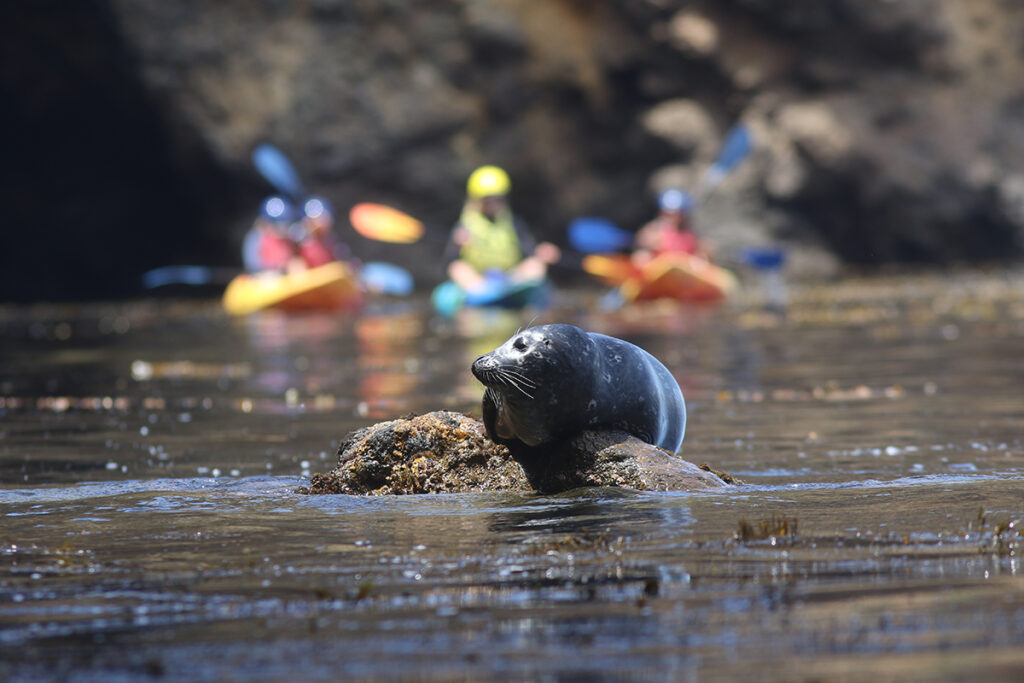
From a distance, kayakers observe a cozy harbor seal soaking up some sun rays. Photo by Chuck Graham.
There’s something about their sweet pushed-in faces and long whiskers, as they seemingly smile at us as we paddle onto the next toothy sea cave around Scorpion Anchorage, on the long southeast finger of Santa Cruz Island.
Spotted harbor seals (Phoca vitulina) are a species of pinniped frequently seen on guided kayak trips with Santa Barbara Adventure Company. They are the friendliest and most curious, but smallest of the six species of seals and sea lions that utilize the Channel Islands National Park for hauling out, breeding, and pupping. They are true seals, meaning they don’t possess external earflaps.
A cute harbor seal keeps a close eye on kayakers pass by. Photo by Chuck Graham.
Around the Scorpion Anchorage region, they rest easy inside Harbor Seal Cave less than a mile northwest of where guided trips begin and end. Usually, they haul out at or above the high tide mark always looking comfy on the steep, rocky backend of the massive grotto. If they don’t move inside the cave, they appear to be just like another rock, blending into their craggy habitat. Sometimes, though, inquisitive harbor seals follow rafts of kayakers from cave to cave, frolicking underwater while guests maneuver through narrow corridors and gaping caverns.
A harbor seal almost appears to smile as it rests on a barnacle-encrusted rock. Photo by Chuck Graham.
However, they can be seen anywhere around the Northern Chain, and because harbor seals don’t migrate far out to sea, not venturing any further out than the Channel Islands, spotting spotted harbor seals is easy to do. While leading kayak tours, guides are aware of the tides and will search for harbor seals on exposed rocks. Some of the same harbor seals seek out their favorite rocks and haul out on them day after day as soon as the tide recedes. Watching a harbor seal clamber up a barnacle-encrusted rock with their short forelimbs is always entertaining, especially if there’s a little bit of swell. They are not the most adept on land, scooching like an inchworm to find that sweet spot on their desired haul-out sites.
Visitors on guided kayak trips will notice that harbor seals make very little noise or nothing at all. The cute, little pups that way 35 pounds at birth, have a light yelp, but as they grow toward adulthood, they are virtually silent. Occasionally, though, an adult will growl at another. Pupping season in the Channel Islands can begin in February, and last into May. The only time harbor seals touch each other is during mating and nursing. You’ll never see them piled on top of each other like raucous California sea lions.
A silvery-colored harbor seal with dark spots. Photo by Chuck Graham.
Besides carrying spots on their fur, harbor seals come in an array of colors. When grouped up on tranquil coves and deserted beaches around the islands, you might see tan, black, brown, and even silvery-colored harbor seals. And wherever they are seen, it’s likely they were born in that region, and remain in that vicinity during their lifespan that can reach 30 years.
A full-grown harbor seal can reach 5-to-6 feet in length, and weigh as much as 350 pounds. Sounds like a lot, right? Not so fast. At the Channel Islands National Park, the harbor seal is tiny compared to their burly cousins, the northern elephant seal (Mirounga angustirostris) that can be seen on Santa Rosa and San Miguel Islands. There are even a few of these brutes on tiny Santa Barbara Island. The bulls can reach 16 feet in length and weigh somewhere between 3,000 to
5,000 pounds!
A large Northern Elephant Seal sleeps on the shoreline of Channel Islands National Park. Photo by Channel Islands National Marine Sanctuary.
On those two remote, windswept isles, harbor seals and northern elephant seals can be seen sharing some of those same wave-battered beaches, one making a lot of noise, and the other peacefully silent.
Blog contributed by:
Chuck Graham